Inside Aztec
Inside
Aztec
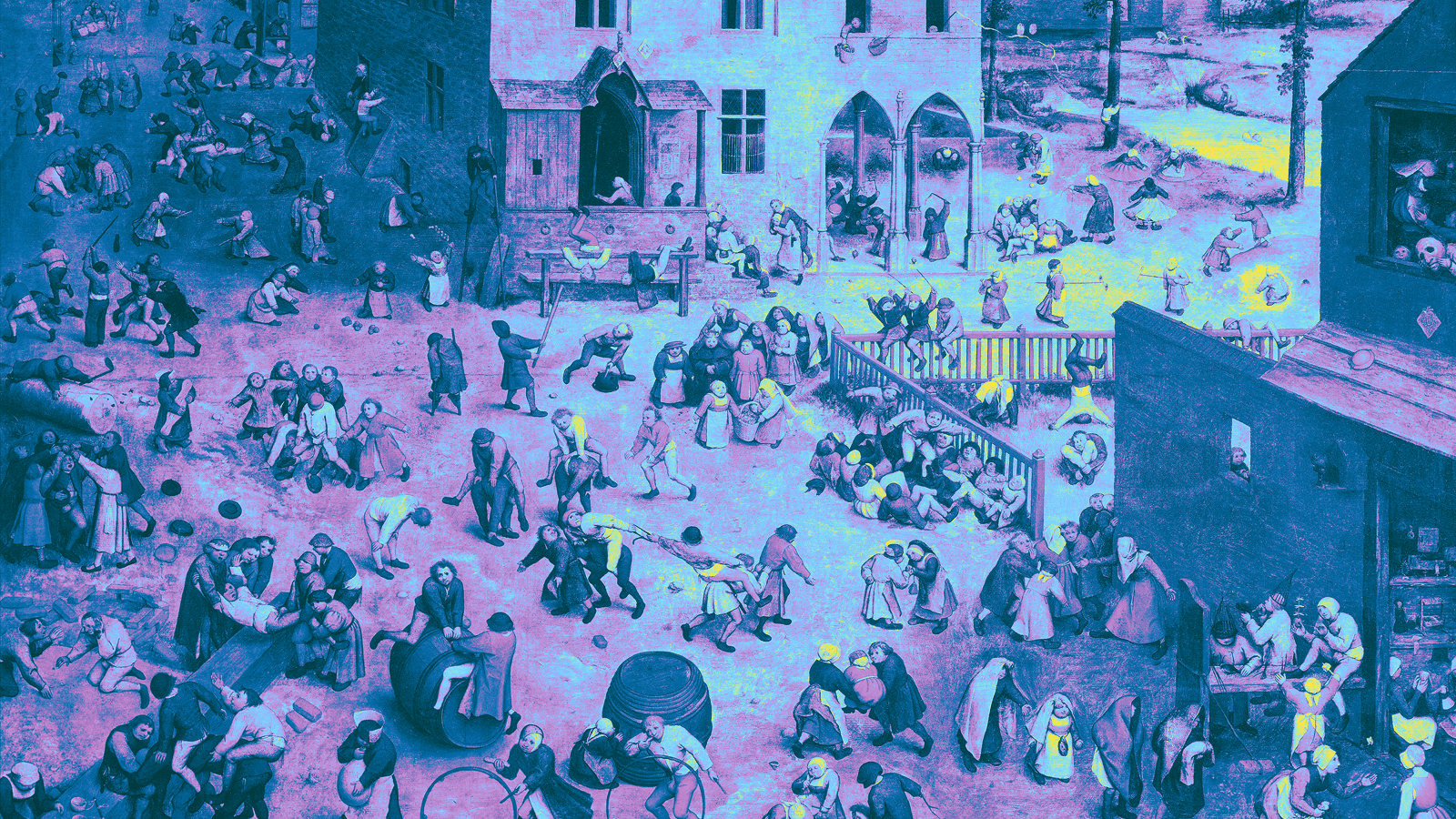

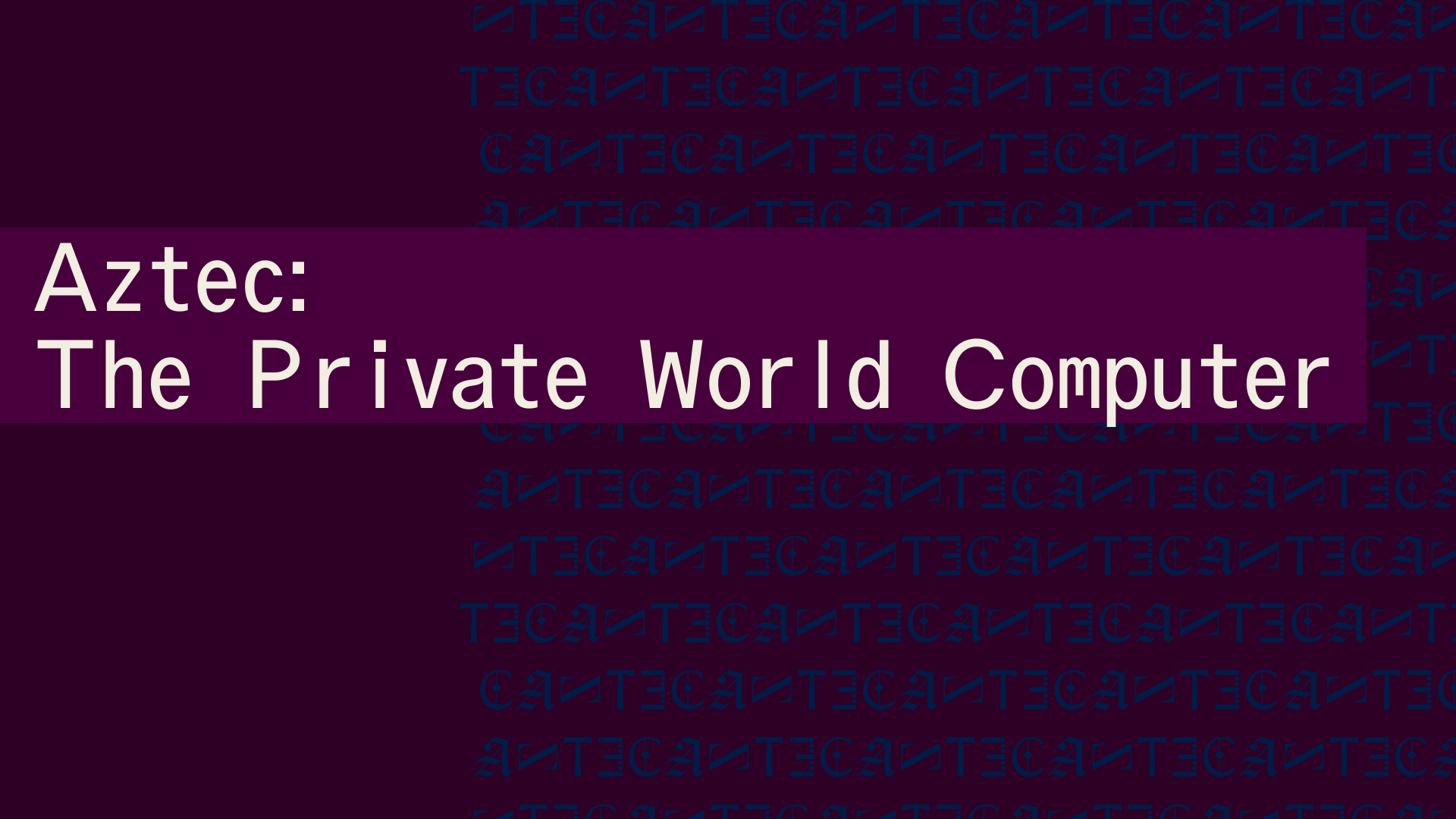
Building a fully decentralized, privacy-preserving network to unlock the next Renaissance.
Privacy has emerged as a major driver for the crypto industry in 2025. We’ve seen the explosion of Zcash, the Ethereum Foundation’s refocusing of PSE, and the launch of Aztec’s testnet with over 24,000 validators powering the network. Many apps have also emerged to bring private transactions to Ethereum and Solana in various ways, and exciting technologies like ZKPassport that privately bring identity on-chain using Noir have become some of the most talked about developments for ushering in the next big movements to the space.
Underpinning all of these developments is the emerging consensus that without privacy, blockchains will struggle to gain real-world adoption.
Without privacy, institutions can’t bring assets on-chain in a compliant way or conduct complex swaps and trades without revealing their strategies. Without privacy, DeFi remains dominated and controlled by advanced traders who can see all upcoming transactions and manipulate the market. Without privacy, regular people will not want to move their lives on-chain for the entire world to see every detail about their every move.
While there's been lots of talk about privacy, few can define it. In this piece we’ll outline the three pillars of privacy and gives you a framework for evaluating the privacy claims of any project.
True privacy rests on three essential pillars: transaction privacy, identity privacy, and computational privacy. It is only when we have all three pillars that we see the emergence of a private world computer.

Transaction privacy means that both inputs and outputs are not viewable by anyone other than the intended participants. Inputs include any asset, value, message, or function calldata that is being sent. Outputs include any state changes or transaction effects, or any transaction metadata caused by the transaction. Transaction privacy is often primarily achieved using a UTXO model (like Zcash or Aztec’s private state tree). If a project has only the option for this pillar, it can be said to be confidential, but not private.
Identity privacy means that the identities of those involved are not viewable by anyone other than the intended participants. This includes addresses or accounts and any information about the identity of the participants, such as tx.origin, msg.sender, or linking one’s private account to public accounts. Identity privacy can be achieved in several ways, including client-side proof generation that keeps all user info on the users’ devices. If a project has only the option for this pillar, it can be said to be anonymous, but not private.
Computation privacy means that any activity that happens is not viewable by anyone other than the intended participants. This includes the contract code itself, function execution, contract address, and full callstack privacy. Additionally, any metadata generated by the transaction is able to be appropriately obfuscated (such as transaction effects, events are appropriately padded, inclusion block number are in appropriate sets). Callstack privacy includes which contracts you call, what functions in those contracts you’ve called, what the results of those functions were, any subsequent functions that will be called after, and what the inputs to the function were. A project must have the option for this pillar to do anything privately other than basic transactions.
Bitcoin ushered in a new paradigm of digital money. As a permissionless, peer-to-peer currency and store of value, it changed the way value could be sent around the world and who could participate. Ethereum expanded this vision to bring us the world computer, a decentralized, general-purpose blockchain with programmable smart contracts.

Given the limitations of running a transparent blockchain that exposes all user activity, accounts, and assets, it was clear that adding the option to preserve privacy would unlock many benefits (and more closely resemble real cash). But this was a very challenging problem. Zcash was one of the first to extend Bitcoin’s functionality with optional privacy, unlocking a new privacy-preserving UTXO model for transacting privately. As we’ll see below, many of the current privacy-focused projects are working on similar kinds of private digital money for Ethereum or other chains.
Now, Aztec is bringing us the final missing piece: a private world computer.
A private world computer is fully decentralized, programmable, and permissionless like Ethereum and has optional privacy at every level. In other words, Aztec is extending all the functionality of Ethereum with optional transaction, identity, and computational privacy. This is the only approach that enables fully compliant, decentralized applications to be built that preserve user privacy, a new design space that we see as ushering in the next Renaissance for the space.
Private digital money emerges when you have the first two privacy pillars covered - transactions and identity - but you don’t have the third - computation. Almost all projects today that claim some level of privacy are working on private digital money. This includes everything from privacy pools on Ethereum and L2s to newly emerging payment L1s like Tempo and Arc that are developing various degrees of transaction privacy
When it comes to digital money, privacy exists on a spectrum. If your identity is hidden but your transactions are visible, that's what we call anonymous. If your transactions are hidden but your identity is known, that's confidential. And when both your identity and transactions are protected, that's true privacy. Projects are working on many different approaches to implement this, from PSE to Payy using Noir, the zkDSL built to make it intuitive to build zk applications using familiar Rust-like syntax.
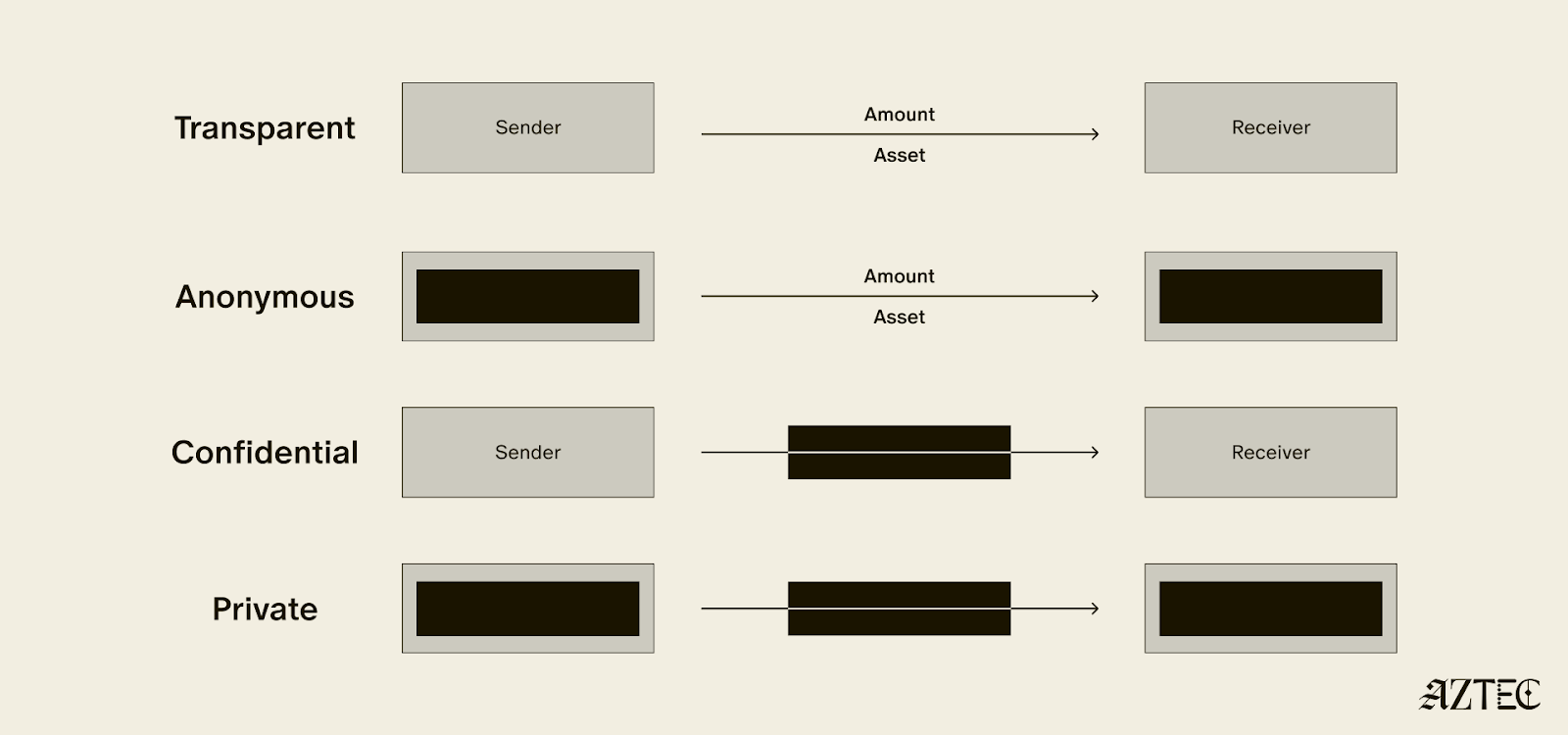
Private digital money is designed to make payments private, but any interaction with more complex smart contracts than a straightforward payment transaction is fully exposed.
What if we also want to build decentralized private apps using smart contracts (usually multiple that talk to each other)? For this, you need all three privacy pillars: transaction, identity, and compute.
If you have these three pillars covered and you have decentralization, you have built a private world computer. Without decentralization, you are vulnerable to censorship, privileged backdoors and inevitable centralized control that can compromise privacy guarantees.
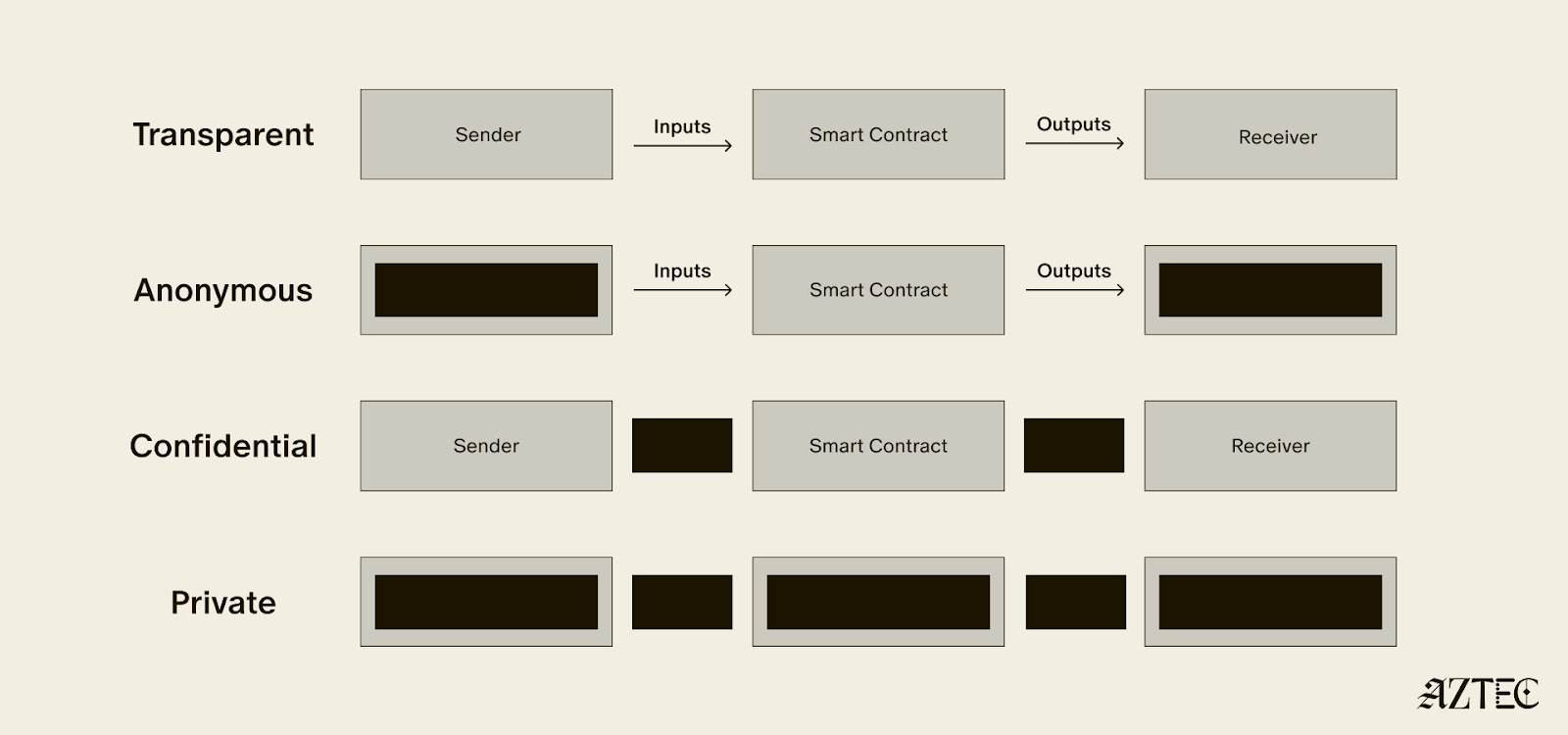
What exactly is a private world computer? A private world computer extends all the functionality of Ethereum with optional privacy at every level, so developers can easily control which aspects they want public or private and users can selectively disclose information. With Aztec, developers can build apps with optional transaction, identity, and compute privacy on a fully decentralized network. Below, we’ll break down the main components of a private world computer.
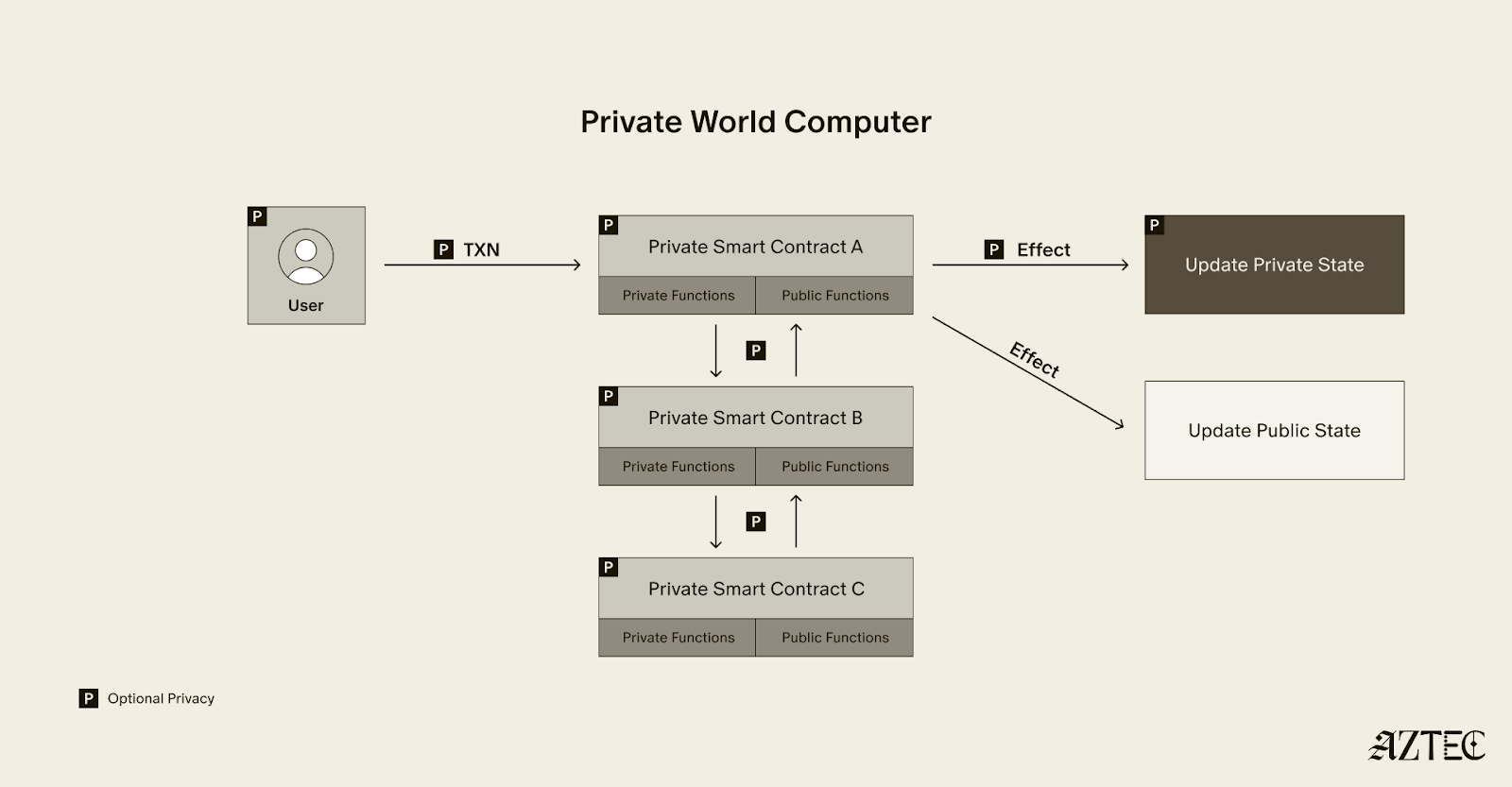
A private world computer is powered by private smart contracts. Private smart contracts have fully optional privacy and also enable seamless public and private function interaction.
Private smart contracts simply extend the functionality of regular smart contracts with added privacy.
As a developer, you can easily designate which functions you want to keep private and which you want to make public. For example, a voting app might allow users to privately cast votes and publicly display the result. Private smart contracts can also interact privately with other smart contracts, without needing to make it public which contracts have interacted.
Transaction: Aztec supports the optionality for fully private inputs, including messages, state, and function calldata. Private state is updated via a private UTXO state tree.
Identity: Using client-side proofs and function execution, Aztec can optionally keep all user info private, including tx.origin and msg.sender for transactions.
Computation: The contract code itself, function execution, and call stack can all be kept private. This includes which contracts you call, what functions in those contracts you’ve called, what the results of those functions were, and what the inputs to the function were.
A decentralized network must be made up of a permissionless network of operators who run the network and decide on upgrades. Aztec is run by a decentralized network of node operators who propose and attest to transactions. Rollup proofs on Aztec are also run by a decentralized prover network that can permissionlessly submit proofs and participate in block rewards. Finally, the Aztec network is governed by the sequencers, who propose, signal, vote, and execute network upgrades.
A private world computer enables the creation of DeFi applications where accounts, transactions, order books, and swaps remain private. Users can protect their trading strategies and positions from public view, preventing front-running and maintaining competitive advantages. Additionally, users can bridge privately into cross-chain DeFi applications, allowing them to participate in DeFi across multiple blockchains while keeping their identity private despite being on an existing transparent blockchain.
This technology makes it possible to bring institutional trading activity on-chain while maintaining the privacy that traditional finance requires. Institutions can privately trade with other institutions globally, without having to touch public markets, enjoying the benefits of blockchain technology such as fast settlement and reduced counterparty risk, without exposing their trading intentions or volumes to the broader market.
Organizations can bring client accounts and assets on-chain while maintaining full compliance. This infrastructure protects on-chain asset trading and settlement strategies, ensuring that sophisticated financial operations remain private. A private world computer also supports private stablecoin issuance and redemption, allowing financial institutions to manage digital currency operations without revealing sensitive business information.
Users have granular control over their privacy settings, allowing them to fine-tune privacy levels for their on-chain identity according to their specific needs. The system enables selective disclosure of on-chain activity, meaning users can choose to reveal certain transactions or holdings to regulators, auditors, or business partners while keeping other information private, meeting compliance requirements.
The shift from transparent blockchains to privacy-preserving infrastructure is the foundation for bringing the next billion users on-chain. Whether you're a developer building the future of private DeFi, an institution exploring compliant on-chain solutions, or simply someone who believes privacy is a fundamental right, now is the time to get involved.
Follow Aztec on X to stay updated on the latest developments in private smart contracts and decentralized privacy technology. Ready to contribute to the network? Run a node and help power the private world computer.
The next Renaissance is here, and it’s being powered by the private world computer.
Special thanks to Santiago Palladino, Phil Windle, Alex Gherghisan, and Mitch Tracy for technical updates and review.
On September 17th, 2025, a new network upgrade was deployed, making Aztec more secure and flexible for home stakers. This upgrade, shipped with all the features needed for a fully decentralized network launch, includes a completely redesigned slashing system that allows inactive or malicious operators to be removed, and does not penalize home stakers for short outages.
With over 23,000 operators running validators across 6 continents (in a variety of conditions), it is critical not to penalize nodes that temporarily drop due to internet connectivity issues. This is because users of the network are also found across the globe, some of whom might have older phones. A significant effort was put into shipping a low-memory proving mode that allows older mobile devices to send transactions and use privacy-preserving apps.
The network was successfully deployed, and all active validators on the old testnet were added to the queue of the new testnet. This manual migration was only necessary because major upgrades to the governance contracts had gone in since the last testnet was deployed. The new testnet started producing blocks after the queue started to be “flushed,” moving validators into the rollup. Because the network is fully decentralized, the initial flush could have been called by anyone. The network produced ~2k blocks before an invalid block made it to the chain and temporarily stalled block production. Block production is now restored and the network is healthy. This post explains what caused the issue and provides an update on the current status of the network.
Note: if you are a network operator, you must upgrade to version 2.0.3 and restart your node to participate in the latest testnet. If you want to run a node, it’s easy to get started.
This upgrade was a team-wide effort that optimized performance and implemented all the mechanisms needed to launch Aztec as a fully decentralized network from day 1.
With these updates in place, we’re ready to test a feature-complete network.
As mentioned above, block production started when someone called the flush function and a minimum number of operators from the queue were let into the validator set.
Shortly thereafter, while testing the network, a member of the Aztec Labs team spun up a “bad” sequencer that produced an invalid block proposal. Specifically, one of the state trees in the proposal was tampered with.

The expectation was that this would be detected immediately and the block rejected. Instead, a bug was discovered in the validator code where the invalid block proposal wasn't checked thoroughly enough. In effect, the proposal got enough attestations, so it was posted to the rollup. Due to extra checks in the nodes, when the nodes pulled the invalid block from Ethereum, they detected the tampered tree and refused to sync it. This is a good outcome as it prevented the attack. Additionally, prover nodes refused to prove the epoch containing the invalid block. This allowed the rollup to prune the entire bad epoch away. After the prune, the invalid state was reset to the last known good block.
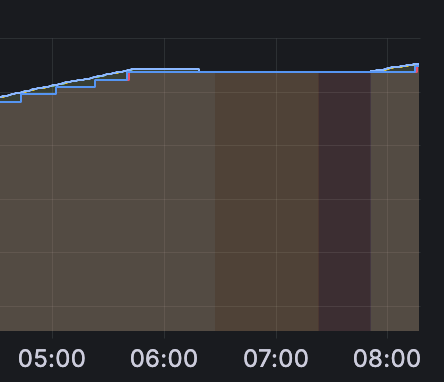
The prune revealed another, smaller bug, where, after a failed block sync, a prune does not get processed correctly, requiring a node restart to clear up. This led to a 90-minute outage from the moment the block proposal was posted until the testnet recovered. The time was equally split between waiting for pruning to happen and for the nodes to restart in order to process the prune.
Validators were correctly re-executing all transactions in the block proposals and verifying that the world state root matched the one in the block proposal, but they failed to check that intermediate tree roots, which are included in the proposal and posted to the rollup contract on L1, were also correct. The attack tweaked one of these intermediate roots while proposing a correct world state root, so it went unnoticed by the attestors.
As mentioned above, even though the block made it through the initial attestation and was posted to L1, the invalid block was caught by the validators, and the entire epoch was never proven as provers refused to generate a proof for the inconsistent state.
A fix was pushed that resolved this issue and ensured that invalid block proposals would be caught and rejected. A second fix was pushed that ensures inconsistent state is removed from the uncommitted cache of the world state.

Block production is currently running smoothly, and the network health has been restored.
Operators who had previously upgraded to version 2.0.3 will need to restart their nodes. Any operator who has not upgraded to 2.0.3 should do so immediately.
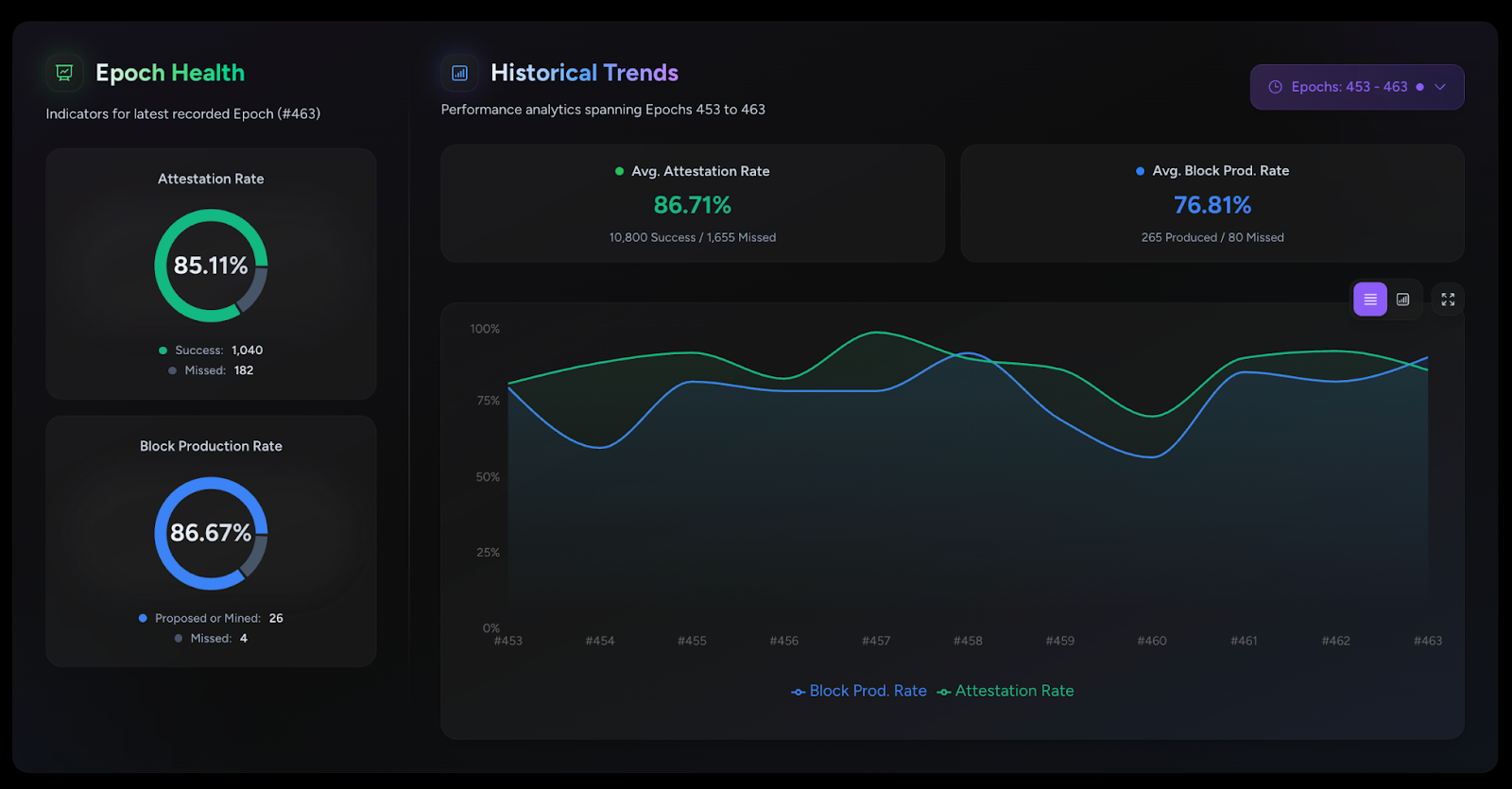
Slashing has also been functioning as expected. Below you can see the slashing signals for each round. A single signal can contain votes for multiple validators, but a validator's attester needs to receive 65 votes to be slashed.
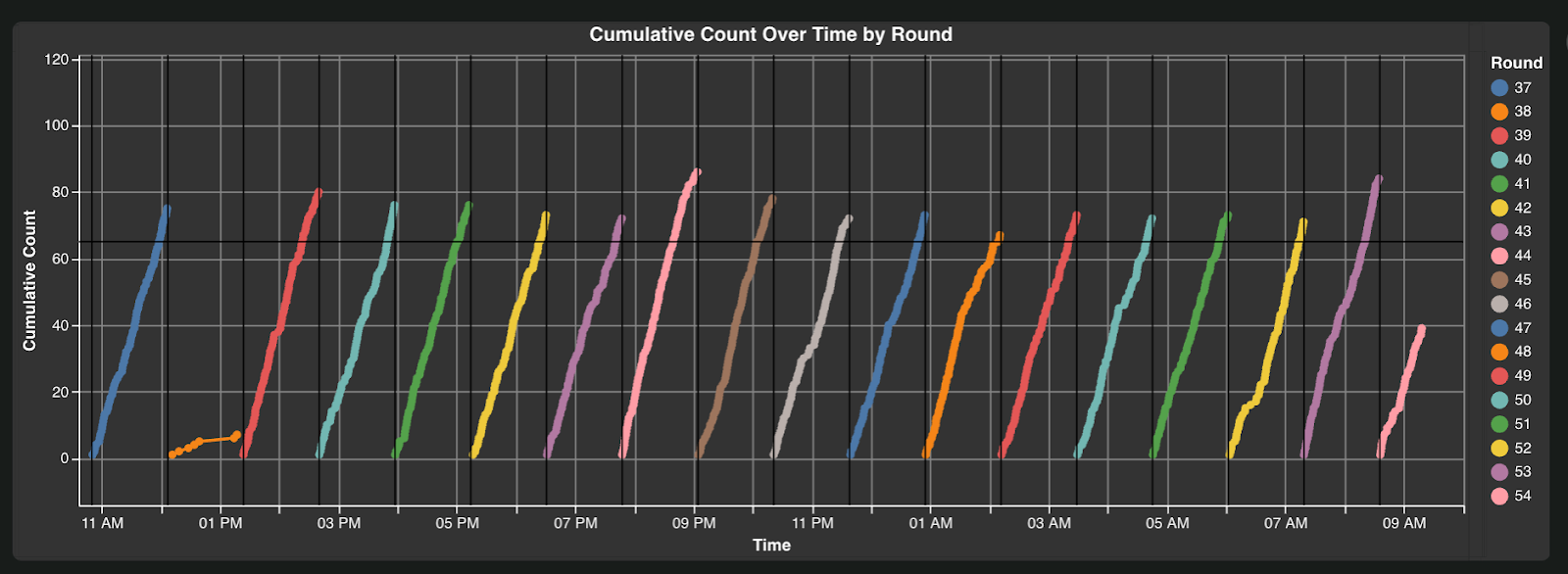
Join us this Thursday, September 25, 2025, at 4 PM CET on the Discord Town Hall to hear more about the 2.0.3 upgrade. To stay up to date with the latest updates for network operators, join the Aztec Discord and follow Aztec on X.
Payy, a privacy-focused payment network, just rewrote its entire ZK architecture from Halo2 to Noir while keeping its network live, funds safe, and users happy.
Code that took months to write now takes weeks (with MVPs built in as little as 30 minutes). Payy’s codebase shrank from thousands of lines to 250, and now their entire engineering team can actually work on its privacy infra.
This is the story of how they transformed their ZK ecosystem from one bottlenecked by a single developer to a system their entire team can modify and maintain.

Eighteen months ago, Payy faced a deceptively simple requirement: build a privacy-preserving payment network that actually works on phones. That requires client-side proving.
"Anyone who tells you they can give you privacy without the proof being on the phone is lying to you," Calum Moore - Payy's Technical Lead - states bluntly.
To make a private, mobile network work, they needed:
To start, the team evaluated available ZK stacks through their zkbench framework:
STARKs (e.g., RISC Zero): Memory requirements made them a non-starter on mobile. Large proof sizes are unsuitable for mobile data transmission.
Circom with Groth16: Required trusted setup ceremonies for each circuit update. It had “abstracted a bit too early” and, as a result, is not high-level enough to develop comfortably, but not low-level enough for controls and optimizations, said Calum.
Halo2: Selected based on existing production deployments (ZCash, Scroll), small proof sizes, and an existing Ethereum verifier. As Calum admitted with the wisdom of hindsight: “Back a year and a half ago, there weren’t any other real options.”
Halo2 delivered on its promises: Payy successfully launched its network. But cracks started showing almost immediately.
First, they had to write their own chips from scratch. Then came the real fun: if statements.
"With Halo2, I'm building a chip, I'm passing this chip in... It's basically a container chip, so you'd set the value to zero or one depending on which way you want it to go. And, you'd zero out the previous value if you didn't want it to make a difference to the calculation," Calum explained, “when I’m writing in Noir, I just write ‘if’. "
With Halo2, writing an if statement (programming 101) required building custom chip infra.
Binary decomposition, another fundamental operation for rollups, meant more custom chips. The Halo2 implementation quickly grew to thousands of lines of incomprehensible code.
And only Calum could touch any of it.
The Bottleneck
"It became this black box that no one could touch, no one could reason about, no one could verify," he recalls. "Obviously, we had it audited, and we were confident in that. But any changes could only be done by me, could only be verified by me or an auditor."
In engineering terms, this is called a bus factor of one: if Calum got hit by a bus (or took a vacation to Argentina), Payy's entire proving system would be frozen. "Those circuits are open source," Calum notes wryly, "but who's gonna be able to read the Halo2 circuits? Nobody."
During a launch event in Argentina, "I was like, oh, I'll check out Noir again. See how it's going," Calum remembers. He'd been tracking Noir's progress for months, occasionally testing it out, waiting for it to be reliable.
"I wrote basically our entire client-side proof in about half an hour in Noir. And it probably took me - I don't know, three weeks to write that proof originally in Halo2."
Calum recreated Payy's client-side proof in Noir in 30 minutes. And when he tested the proving speed, without any optimization, they were seeing 2x speed improvements.
"I kind of internally… didn't want to tell my cofounder Sid that I'd already made my decision to move to Noir," Calum admits. "I hadn't broken it to him yet because it's hard to justify rewriting your proof system when you have a deployed network with a bunch of money already on the network and a bunch of users."
Convincing a team to rewrite the core of a live financial network takes some evidence. The technical evaluation of Noir revealed improvements across every metric:
Proof Generation Time: Sub-0.5 second proof generation on iPhones. "We're obsessive about performance," Calum notes (they’re confident they can push it even further).
Code Complexity: Their entire ZK implementation compressed from thousands of lines of Halo2 to just 250 lines of Noir code. "With rollups, the logic isn't complex—it's more about the preciseness of the logic," Calum explains.
Composability: In Halo2, proof aggregation required hardwiring specific verifiers for each proof type. Noir offers a general-purpose verifier that accepts any proof of consistent size.
"We can have 100 different proving systems, which are hyper-efficient for the kind of application that we're doing," Calum explains. "Have them all aggregated by the same aggregation proof, and reason about whatever needs to be."
Initially, the goal was to "completely mirror our Halo2 proofs": no new features. This conservative approach meant they could verify correctness while maintaining a live network.
The migration preserved Payy's production architecture:
"If you have your proofs in Noir, any person who understands even a little bit about logic or computers can go in and say, 'okay, I can kinda see what's happening here'," Calum notes.
The audit process completely transformed. With Halo2: "The auditors that are available to audit Halo2 are few and far between."
With Noir: "You could have an auditor that had no Noir experience do at least a 95% job."
Why? Most audit issues are logic errors, not ZK-specific bugs. When auditors can read your code, they find real problems instead of getting lost in implementation details.
Halo2: Binary decomposition
Payy’s previous 383 line implementation of binary decomposition can be viewed here (pkg/zk-circuits/src/chips/binary_decomposition.rs).
Payy’s previous binary decomposition implementation
Meanwhile, binary decomposition is handled in Noir with the following single line.
pub fn to_le_bits<let N: u32>(self: Self) -> [u1; N]
(Source)
With Noir's composable proof system, Payy can now build specialized provers for different operations, each optimized for its specific task.
"If statements are horrendous in SNARKs because you pay the cost of the if statement regardless of its run," Calum explains. But with Noir's approach, "you can split your application logic into separate proofs, and run whichever proof is for the specific application you're looking for."
Instead of one monolithic proof trying to handle every case, you can have specialized proofs, each perfect for its purpose.
"I fell a little bit in love with Halo2," Calum admits, "maybe it's Stockholm syndrome where you're like, you know, it's a love-hate relationship, and it's really hard. But at the same time, when you get a breakthrough with it, you're like, yes, I feel really good because I'm basically writing assembly-level ZK proofs."
“But now? I just write ‘if’.”
Technical Note: While "migrating from Halo2 to Noir" is shorthand that works for this article, technically Halo2 is an integrated proving system where circuits must be written directly in Rust using its constraint APIs, while Noir is a high-level language that compiles to an intermediate representation and can use various proving backends. Payy specifically moved from writing circuits in Halo2's low-level constraint system to writing them in Noir's high-level language, with Barretenberg (UltraHonk) as their proving backend.
Both tools ultimately enable developers to write circuits and generate proofs, but Noir's modular architecture separates circuit logic from the proving system - which is what made Payy's circuits so much more accessible to their entire team, and now allows them to swap out their proving system with minimal effort as proving systems improve.
Payy's code is open source and available for developers looking to learn from their implementation.
After eight years of solving impossible problems, the next renaissance is here.
We’re at a major inflection point, with both our tech and our builder community going through growth spurts. The purpose of this rebrand is simple: to draw attention to our full-stack privacy-native network and to elevate the rich community of builders who are creating a thriving ecosystem around it.
For eight years, we’ve been obsessed with solving impossible challenges. We invented new cryptography (Plonk), created an intuitive programming language (Noir), and built the first decentralized network on Ethereum where privacy is native rather than an afterthought.
It wasn't easy. But now, we're finally bringing that powerful network to life. Testnet is live with thousands of active users and projects that were technically impossible before Aztec.
Our community evolution mirrors our technical progress. What started as an intentionally small, highly engaged group of cracked developers is now welcoming waves of developers eager to build applications that mainstream users actually want and need.
A brand is more than aesthetics—it's a mental model that makes Aztec's spirit tangible.
Renaissance means "rebirth"—and that's exactly what happens when developers gain access to privacy-first infrastructure. We're witnessing the emergence of entirely new application categories, business models, and user experiences.
The faces of this renaissance are the builders we serve: the entrepreneurs building privacy-preserving DeFi, the activists building identity systems that protect user privacy, the enterprise architects tokenizing real-world assets, and the game developers creating experiences with hidden information.
This next renaissance isn't just about technology—it's about the ethos behind the build. These aren't just our values. They're the shared DNA of every builder pushing the boundaries of what's possible on Aztec.
Agency: It’s what everyone deserves, and very few truly have: the ability to choose and take action for ourselves. On the Aztec Network, agency is native
Genius: That rare cocktail of existential thirst, extraordinary brilliance, and mind-bending creation. It’s fire that fuels our great leaps forward.
Integrity: It’s the respect and compassion we show each other. Our commitment to attacking the hardest problems first, and the excellence we demand of any solution.
Obsession: That highly concentrated insanity, extreme doggedness, and insatiable devotion that makes us tick. We believe in a different future—and we can make it happen, together.
Just as our technology bridges different eras of cryptographic innovation, our new visual identity draws from multiple periods of human creativity and technological advancement.
Our new wordmark embodies the diversity of our community and the permissionless nature of our network. Each letter was custom-drawn to reflect different pivotal moments in human communication and technological progress.
Together, these letters tell the story of human innovation: each era building on the last, each breakthrough enabling the next renaissance. And now, we're building the infrastructure for the one that's coming.
We evolved our original icon to reflect this new chapter while honoring our foundation. The layered diamond structure tells the story:
The architecture echoes a central plaza—the Roman forum, the Greek agora, the English commons, the American town square—places where people gather, exchange ideas, build relationships, and shape culture. It's a fitting symbol for the infrastructure enabling the next leap in human coordination and creativity.
From the Mughal and Edo periods to the Flemish and Italian Renaissance, our brand imagery draws from different cultures and eras of extraordinary human flourishing—periods when science, commerce, culture and technology converged to create unprecedented leaps forward. These visuals reflect both the universal nature of the Renaissance and the global reach of our network.
But we're not just celebrating the past —we're creating the future: the infrastructure for humanity's next great creative and technological awakening, powered by privacy-native blockchain technology.
Join us to ask questions, learn more and dive into the lore.
Join Our Discord Town Hall. September 4th at 8 AM PT, then every Thursday at 7 AM PT. Come hear directly from our team, ask questions, and connect with other builders who are shaping the future of privacy-first applications.
Take your stance on privacy. Visit the privacy glyph generator to create your custom profile pic and build this new world with us.
Stay Connected. Visit the new website and to stay up-to-date on all things Noir and Aztec, make sure you’re following along on X.
The next renaissance is what you build on Aztec—and we can't wait to see what you'll create.
Aztec’s Public Testnet launched in May 2025.
Since then, we’ve been obsessively working toward our ultimate goal: launching the first fully decentralized privacy-preserving layer-2 (L2) network on Ethereum. This effort has involved a team of over 70 people, including world-renowned cryptographers and builders, with extensive collaboration from the Aztec community.
To make something private is one thing, but to also make it decentralized is another. Privacy is only half of the story. Every component of the Aztec Network will be decentralized from day one because decentralization is the foundation that allows privacy to be enforced by code, not by trust. This includes sequencers, which order and validate transactions, provers, which create privacy-preserving cryptographic proofs, and settlement on Ethereum, which finalizes transactions on the secure Ethereum mainnet to ensure trust and immutability.
Strong progress is being made by the community toward full decentralization. The Aztec Network now includes nearly 1,000 sequencers in its validator set, with 15,000 nodes spread across more than 50 countries on six continents. With this globally distributed network in place, the Aztec Network is ready for users to stress test and challenge its resilience.
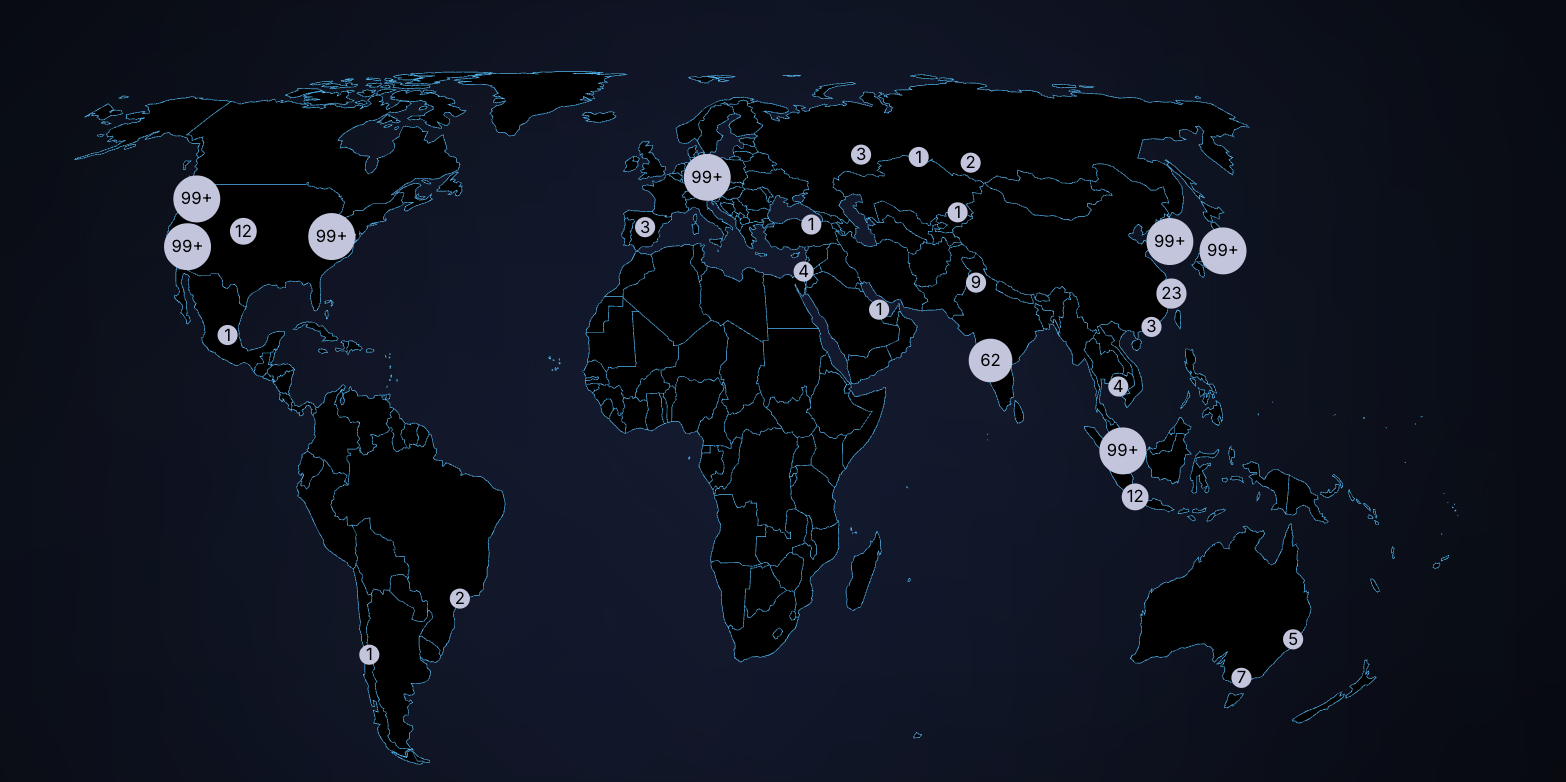
We're now entering a new phase: the Adversarial Testnet. This stage will test the resilience of the Aztec Testnet and its decentralization mechanisms.
The Adversarial Testnet introduces two key features: slashing, which penalizes validators for malicious or negligent behavior in Proof-of-Stake (PoS) networks, and a fully decentralized governance mechanism for protocol upgrades.
This phase will also simulate network attacks to test its ability to recover independently, ensuring it could continue to operate even if the core team and servers disappeared (see more on Vitalik’s “walkaway test” here). It also opens the validator set to more people using ZKPassport, a private identity verification app, to verify their identity online.
The Aztec Network testnet is decentralized, run by a permissionless network of sequencers.
The slashing upgrade tests one of the most fundamental mechanisms for removing inactive or malicious sequencers from the validator set, an essential step toward strengthening decentralization.
Similar to Ethereum, on the Aztec Network, any inactive or malicious sequencers will be slashed and removed from the validator set. Sequencers will be able to slash any validator that makes no attestations for an entire epoch or proposes an invalid block.
Three slashes will result in being removed from the validator set. Sequencers may rejoin the validator set at any time after getting slashed; they just need to rejoin the queue.
In addition to testing network resilience when validators go offline and evaluating the slashing mechanisms, the Adversarial Testnet will also assess the robustness of the network’s decentralized governance during protocol upgrades.
Adversarial Testnet introduces changes to Aztec Network’s governance system.
Sequencers now have an even more central role, as they are the sole actors permitted to deposit assets into the Governance contract.
After the upgrade is defined and the proposed contracts are deployed, sequencers will vote on and implement the upgrade independently, without any involvement from Aztec Labs and/or the Aztec Foundation.
Starting today, you can join the Adversarial Testnet to help battle-test Aztec’s decentralization and security. Anyone can compete in six categories for a chance to win exclusive Aztec swag, be featured on the Aztec X account, and earn a DappNode. The six challenge categories include:
Performance will be tracked using Dashtec, a community-built dashboard that pulls data from publicly available sources. Dashtec displays a weighted score of your validator performance, which may be used to evaluate challenges and award prizes.
The dashboard offers detailed insights into sequencer performance through a stunning UI, allowing users to see exactly who is in the current validator set and providing a block-by-block view of every action taken by sequencers.
To join the validator set and start tracking your performance, click here. Join us on Thursday, July 31, 2025, at 4 pm CET on Discord for a Town Hall to hear more about the challenges and prizes. Who knows, we might even drop some alpha.
To stay up-to-date on all things Noir and Aztec, make sure you’re following along on X.
Privacy has emerged as a major driver for the crypto industry in 2025. We’ve seen the explosion of Zcash, the Ethereum Foundation’s refocusing of PSE, and the launch of Aztec’s testnet with over 24,000 validators powering the network. Many apps have also emerged to bring private transactions to Ethereum and Solana in various ways, and exciting technologies like ZKPassport that privately bring identity on-chain using Noir have become some of the most talked about developments for ushering in the next big movements to the space.
Underpinning all of these developments is the emerging consensus that without privacy, blockchains will struggle to gain real-world adoption.
Without privacy, institutions can’t bring assets on-chain in a compliant way or conduct complex swaps and trades without revealing their strategies. Without privacy, DeFi remains dominated and controlled by advanced traders who can see all upcoming transactions and manipulate the market. Without privacy, regular people will not want to move their lives on-chain for the entire world to see every detail about their every move.
While there's been lots of talk about privacy, few can define it. In this piece we’ll outline the three pillars of privacy and gives you a framework for evaluating the privacy claims of any project.
True privacy rests on three essential pillars: transaction privacy, identity privacy, and computational privacy. It is only when we have all three pillars that we see the emergence of a private world computer.

Transaction privacy means that both inputs and outputs are not viewable by anyone other than the intended participants. Inputs include any asset, value, message, or function calldata that is being sent. Outputs include any state changes or transaction effects, or any transaction metadata caused by the transaction. Transaction privacy is often primarily achieved using a UTXO model (like Zcash or Aztec’s private state tree). If a project has only the option for this pillar, it can be said to be confidential, but not private.
Identity privacy means that the identities of those involved are not viewable by anyone other than the intended participants. This includes addresses or accounts and any information about the identity of the participants, such as tx.origin, msg.sender, or linking one’s private account to public accounts. Identity privacy can be achieved in several ways, including client-side proof generation that keeps all user info on the users’ devices. If a project has only the option for this pillar, it can be said to be anonymous, but not private.
Computation privacy means that any activity that happens is not viewable by anyone other than the intended participants. This includes the contract code itself, function execution, contract address, and full callstack privacy. Additionally, any metadata generated by the transaction is able to be appropriately obfuscated (such as transaction effects, events are appropriately padded, inclusion block number are in appropriate sets). Callstack privacy includes which contracts you call, what functions in those contracts you’ve called, what the results of those functions were, any subsequent functions that will be called after, and what the inputs to the function were. A project must have the option for this pillar to do anything privately other than basic transactions.
Bitcoin ushered in a new paradigm of digital money. As a permissionless, peer-to-peer currency and store of value, it changed the way value could be sent around the world and who could participate. Ethereum expanded this vision to bring us the world computer, a decentralized, general-purpose blockchain with programmable smart contracts.

Given the limitations of running a transparent blockchain that exposes all user activity, accounts, and assets, it was clear that adding the option to preserve privacy would unlock many benefits (and more closely resemble real cash). But this was a very challenging problem. Zcash was one of the first to extend Bitcoin’s functionality with optional privacy, unlocking a new privacy-preserving UTXO model for transacting privately. As we’ll see below, many of the current privacy-focused projects are working on similar kinds of private digital money for Ethereum or other chains.
Now, Aztec is bringing us the final missing piece: a private world computer.
A private world computer is fully decentralized, programmable, and permissionless like Ethereum and has optional privacy at every level. In other words, Aztec is extending all the functionality of Ethereum with optional transaction, identity, and computational privacy. This is the only approach that enables fully compliant, decentralized applications to be built that preserve user privacy, a new design space that we see as ushering in the next Renaissance for the space.
Private digital money emerges when you have the first two privacy pillars covered - transactions and identity - but you don’t have the third - computation. Almost all projects today that claim some level of privacy are working on private digital money. This includes everything from privacy pools on Ethereum and L2s to newly emerging payment L1s like Tempo and Arc that are developing various degrees of transaction privacy
When it comes to digital money, privacy exists on a spectrum. If your identity is hidden but your transactions are visible, that's what we call anonymous. If your transactions are hidden but your identity is known, that's confidential. And when both your identity and transactions are protected, that's true privacy. Projects are working on many different approaches to implement this, from PSE to Payy using Noir, the zkDSL built to make it intuitive to build zk applications using familiar Rust-like syntax.

Private digital money is designed to make payments private, but any interaction with more complex smart contracts than a straightforward payment transaction is fully exposed.
What if we also want to build decentralized private apps using smart contracts (usually multiple that talk to each other)? For this, you need all three privacy pillars: transaction, identity, and compute.
If you have these three pillars covered and you have decentralization, you have built a private world computer. Without decentralization, you are vulnerable to censorship, privileged backdoors and inevitable centralized control that can compromise privacy guarantees.

What exactly is a private world computer? A private world computer extends all the functionality of Ethereum with optional privacy at every level, so developers can easily control which aspects they want public or private and users can selectively disclose information. With Aztec, developers can build apps with optional transaction, identity, and compute privacy on a fully decentralized network. Below, we’ll break down the main components of a private world computer.

A private world computer is powered by private smart contracts. Private smart contracts have fully optional privacy and also enable seamless public and private function interaction.
Private smart contracts simply extend the functionality of regular smart contracts with added privacy.
As a developer, you can easily designate which functions you want to keep private and which you want to make public. For example, a voting app might allow users to privately cast votes and publicly display the result. Private smart contracts can also interact privately with other smart contracts, without needing to make it public which contracts have interacted.
Transaction: Aztec supports the optionality for fully private inputs, including messages, state, and function calldata. Private state is updated via a private UTXO state tree.
Identity: Using client-side proofs and function execution, Aztec can optionally keep all user info private, including tx.origin and msg.sender for transactions.
Computation: The contract code itself, function execution, and call stack can all be kept private. This includes which contracts you call, what functions in those contracts you’ve called, what the results of those functions were, and what the inputs to the function were.
A decentralized network must be made up of a permissionless network of operators who run the network and decide on upgrades. Aztec is run by a decentralized network of node operators who propose and attest to transactions. Rollup proofs on Aztec are also run by a decentralized prover network that can permissionlessly submit proofs and participate in block rewards. Finally, the Aztec network is governed by the sequencers, who propose, signal, vote, and execute network upgrades.
A private world computer enables the creation of DeFi applications where accounts, transactions, order books, and swaps remain private. Users can protect their trading strategies and positions from public view, preventing front-running and maintaining competitive advantages. Additionally, users can bridge privately into cross-chain DeFi applications, allowing them to participate in DeFi across multiple blockchains while keeping their identity private despite being on an existing transparent blockchain.
This technology makes it possible to bring institutional trading activity on-chain while maintaining the privacy that traditional finance requires. Institutions can privately trade with other institutions globally, without having to touch public markets, enjoying the benefits of blockchain technology such as fast settlement and reduced counterparty risk, without exposing their trading intentions or volumes to the broader market.
Organizations can bring client accounts and assets on-chain while maintaining full compliance. This infrastructure protects on-chain asset trading and settlement strategies, ensuring that sophisticated financial operations remain private. A private world computer also supports private stablecoin issuance and redemption, allowing financial institutions to manage digital currency operations without revealing sensitive business information.
Users have granular control over their privacy settings, allowing them to fine-tune privacy levels for their on-chain identity according to their specific needs. The system enables selective disclosure of on-chain activity, meaning users can choose to reveal certain transactions or holdings to regulators, auditors, or business partners while keeping other information private, meeting compliance requirements.
The shift from transparent blockchains to privacy-preserving infrastructure is the foundation for bringing the next billion users on-chain. Whether you're a developer building the future of private DeFi, an institution exploring compliant on-chain solutions, or simply someone who believes privacy is a fundamental right, now is the time to get involved.
Follow Aztec on X to stay updated on the latest developments in private smart contracts and decentralized privacy technology. Ready to contribute to the network? Run a node and help power the private world computer.
The next Renaissance is here, and it’s being powered by the private world computer.
After eight years of solving impossible problems, the next renaissance is here.
We’re at a major inflection point, with both our tech and our builder community going through growth spurts. The purpose of this rebrand is simple: to draw attention to our full-stack privacy-native network and to elevate the rich community of builders who are creating a thriving ecosystem around it.
For eight years, we’ve been obsessed with solving impossible challenges. We invented new cryptography (Plonk), created an intuitive programming language (Noir), and built the first decentralized network on Ethereum where privacy is native rather than an afterthought.
It wasn't easy. But now, we're finally bringing that powerful network to life. Testnet is live with thousands of active users and projects that were technically impossible before Aztec.
Our community evolution mirrors our technical progress. What started as an intentionally small, highly engaged group of cracked developers is now welcoming waves of developers eager to build applications that mainstream users actually want and need.
A brand is more than aesthetics—it's a mental model that makes Aztec's spirit tangible.
Renaissance means "rebirth"—and that's exactly what happens when developers gain access to privacy-first infrastructure. We're witnessing the emergence of entirely new application categories, business models, and user experiences.
The faces of this renaissance are the builders we serve: the entrepreneurs building privacy-preserving DeFi, the activists building identity systems that protect user privacy, the enterprise architects tokenizing real-world assets, and the game developers creating experiences with hidden information.
This next renaissance isn't just about technology—it's about the ethos behind the build. These aren't just our values. They're the shared DNA of every builder pushing the boundaries of what's possible on Aztec.
Agency: It’s what everyone deserves, and very few truly have: the ability to choose and take action for ourselves. On the Aztec Network, agency is native
Genius: That rare cocktail of existential thirst, extraordinary brilliance, and mind-bending creation. It’s fire that fuels our great leaps forward.
Integrity: It’s the respect and compassion we show each other. Our commitment to attacking the hardest problems first, and the excellence we demand of any solution.
Obsession: That highly concentrated insanity, extreme doggedness, and insatiable devotion that makes us tick. We believe in a different future—and we can make it happen, together.
Just as our technology bridges different eras of cryptographic innovation, our new visual identity draws from multiple periods of human creativity and technological advancement.
Our new wordmark embodies the diversity of our community and the permissionless nature of our network. Each letter was custom-drawn to reflect different pivotal moments in human communication and technological progress.
Together, these letters tell the story of human innovation: each era building on the last, each breakthrough enabling the next renaissance. And now, we're building the infrastructure for the one that's coming.
We evolved our original icon to reflect this new chapter while honoring our foundation. The layered diamond structure tells the story:
The architecture echoes a central plaza—the Roman forum, the Greek agora, the English commons, the American town square—places where people gather, exchange ideas, build relationships, and shape culture. It's a fitting symbol for the infrastructure enabling the next leap in human coordination and creativity.
From the Mughal and Edo periods to the Flemish and Italian Renaissance, our brand imagery draws from different cultures and eras of extraordinary human flourishing—periods when science, commerce, culture and technology converged to create unprecedented leaps forward. These visuals reflect both the universal nature of the Renaissance and the global reach of our network.
But we're not just celebrating the past —we're creating the future: the infrastructure for humanity's next great creative and technological awakening, powered by privacy-native blockchain technology.
Join us to ask questions, learn more and dive into the lore.
Join Our Discord Town Hall. September 4th at 8 AM PT, then every Thursday at 7 AM PT. Come hear directly from our team, ask questions, and connect with other builders who are shaping the future of privacy-first applications.
Take your stance on privacy. Visit the privacy glyph generator to create your custom profile pic and build this new world with us.
Stay Connected. Visit the new website and to stay up-to-date on all things Noir and Aztec, make sure you’re following along on X.
The next renaissance is what you build on Aztec—and we can't wait to see what you'll create.
Aztec’s Public Testnet launched in May 2025.
Since then, we’ve been obsessively working toward our ultimate goal: launching the first fully decentralized privacy-preserving layer-2 (L2) network on Ethereum. This effort has involved a team of over 70 people, including world-renowned cryptographers and builders, with extensive collaboration from the Aztec community.
To make something private is one thing, but to also make it decentralized is another. Privacy is only half of the story. Every component of the Aztec Network will be decentralized from day one because decentralization is the foundation that allows privacy to be enforced by code, not by trust. This includes sequencers, which order and validate transactions, provers, which create privacy-preserving cryptographic proofs, and settlement on Ethereum, which finalizes transactions on the secure Ethereum mainnet to ensure trust and immutability.
Strong progress is being made by the community toward full decentralization. The Aztec Network now includes nearly 1,000 sequencers in its validator set, with 15,000 nodes spread across more than 50 countries on six continents. With this globally distributed network in place, the Aztec Network is ready for users to stress test and challenge its resilience.

We're now entering a new phase: the Adversarial Testnet. This stage will test the resilience of the Aztec Testnet and its decentralization mechanisms.
The Adversarial Testnet introduces two key features: slashing, which penalizes validators for malicious or negligent behavior in Proof-of-Stake (PoS) networks, and a fully decentralized governance mechanism for protocol upgrades.
This phase will also simulate network attacks to test its ability to recover independently, ensuring it could continue to operate even if the core team and servers disappeared (see more on Vitalik’s “walkaway test” here). It also opens the validator set to more people using ZKPassport, a private identity verification app, to verify their identity online.
The Aztec Network testnet is decentralized, run by a permissionless network of sequencers.
The slashing upgrade tests one of the most fundamental mechanisms for removing inactive or malicious sequencers from the validator set, an essential step toward strengthening decentralization.
Similar to Ethereum, on the Aztec Network, any inactive or malicious sequencers will be slashed and removed from the validator set. Sequencers will be able to slash any validator that makes no attestations for an entire epoch or proposes an invalid block.
Three slashes will result in being removed from the validator set. Sequencers may rejoin the validator set at any time after getting slashed; they just need to rejoin the queue.
In addition to testing network resilience when validators go offline and evaluating the slashing mechanisms, the Adversarial Testnet will also assess the robustness of the network’s decentralized governance during protocol upgrades.
Adversarial Testnet introduces changes to Aztec Network’s governance system.
Sequencers now have an even more central role, as they are the sole actors permitted to deposit assets into the Governance contract.
After the upgrade is defined and the proposed contracts are deployed, sequencers will vote on and implement the upgrade independently, without any involvement from Aztec Labs and/or the Aztec Foundation.
Starting today, you can join the Adversarial Testnet to help battle-test Aztec’s decentralization and security. Anyone can compete in six categories for a chance to win exclusive Aztec swag, be featured on the Aztec X account, and earn a DappNode. The six challenge categories include:
Performance will be tracked using Dashtec, a community-built dashboard that pulls data from publicly available sources. Dashtec displays a weighted score of your validator performance, which may be used to evaluate challenges and award prizes.
The dashboard offers detailed insights into sequencer performance through a stunning UI, allowing users to see exactly who is in the current validator set and providing a block-by-block view of every action taken by sequencers.
To join the validator set and start tracking your performance, click here. Join us on Thursday, July 31, 2025, at 4 pm CET on Discord for a Town Hall to hear more about the challenges and prizes. Who knows, we might even drop some alpha.
To stay up-to-date on all things Noir and Aztec, make sure you’re following along on X.
On May 1st, 2025, Aztec Public Testnet went live.
Within the first 24 hours, over 20k users visited the Aztec Playground and started to send transactions on testnet. Additionally, 10 apps launched live on the testnet, including wallets, block explorers, and private DeFi and NFT marketplaces. Launching a decentralized testnet poses significant challenges, and we’re proud that the network has continued to run despite high levels of congestion that led to slow block production for a period of time.
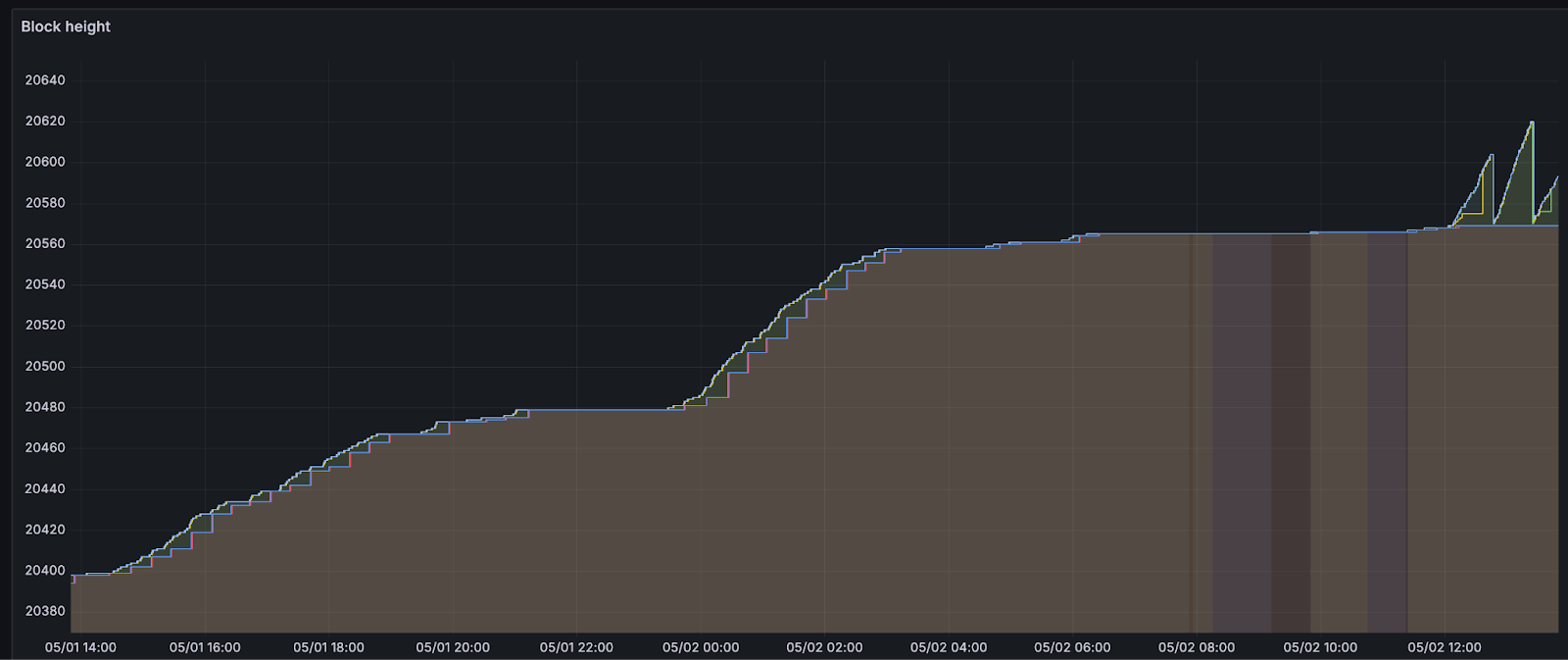
Around 6 hours after announcing the network launch, more than 150 sequencers had joined the validator set to sequence transactions and propose blocks for the network. 500+ additional full nodes were spun up by node operators participating in our Discord community. These sequencers were flooded with over 5k transactions before block production slowed. Let’s dive into why block production slowed down.
On Aztec, an epoch is a group of 32 blocks that are rolled up for settlement on Ethereum. Leading up to the slowdown of block production, there were entire epochs with full blocks (8 transactions, or 0.2TPS) in every slot. The sequencers were building blocks and absorbing the demand for blockspace from users of the Aztec playground, and there was a build up of 100s of pending transactions in sequencer mempools.
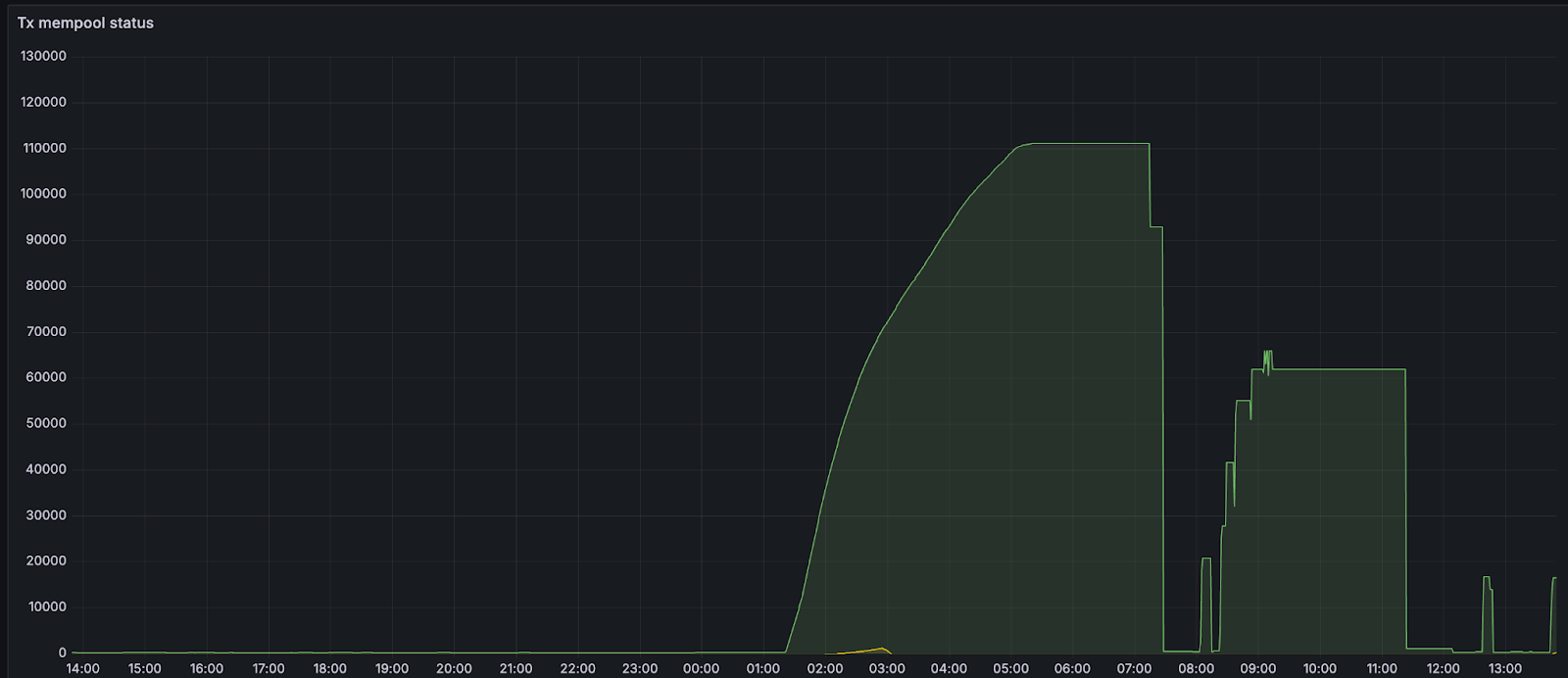
Issues arose when these transactions started to exceed the mempool size, which was configured to hold only 100mb or about 700 transactions.
As many new validators were brought through the funnel and started to come online, the mempools of existing validators (already full at 700 transactions) and new ones (at 0 transactions) diverged significantly. When earlier validators proposed blocks, newer validators didn't have the transactions and could not attest to blocks because the request/response protocol wasn't aggressive enough. When newer validators made proposals, earlier validators didn't have transactions (their mempools were full), so they could not attest to blocks.
New validators then started to build up pending transactions. When validators with full mempools requested missing transactions from peers, they would evict existing transactions from their mempools (mempool is at max memory) based on priority fee. All transactions had default fee settings, so validators were randomly ejecting transactions and were not doing so in lockstep (different validators ejected different transactions). For a little over an hour, the mempools diverged significantly from each other, and block production slowed down to about 20% of the expected rate.
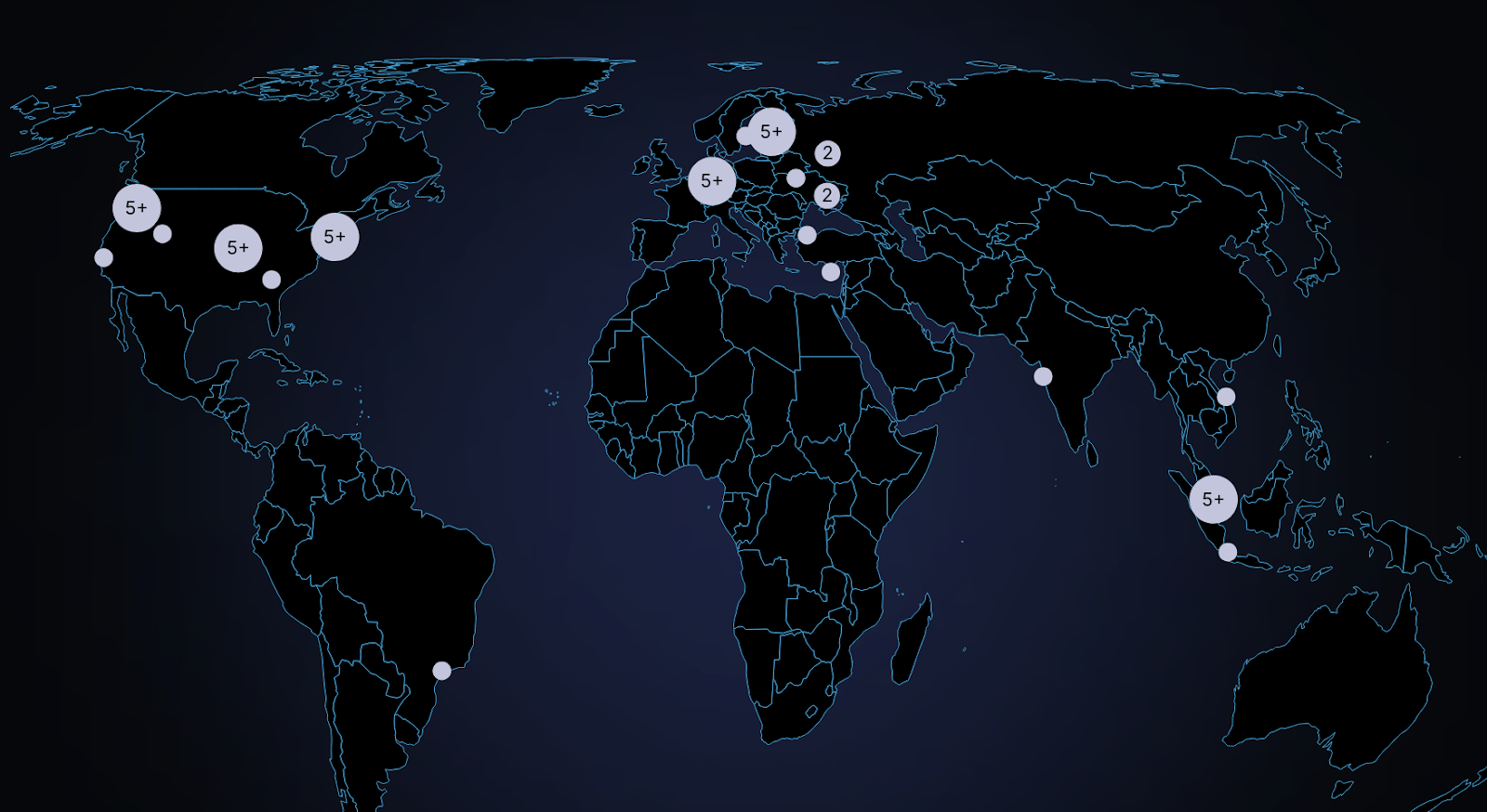
In order to stop the mempool from ejecting transactions, the p2p mempool size was increased. By increasing the mempool size, the likelihood of needing to evict transactions that might soon appear in proposals is reduced. This increases the chances that sequencers already have the necessary transactions locally when they receive a block proposal. As a result, more validators are able to attest to proposals, allowing blocks to be finalized more reliably. Once blocks are included on L1, their transactions are evicted from the mempool. So over time, as more blocks are finalized and transactions are mined, the mempool naturally shrinks and the network will recover on its own.
If you are interested in running a sequencer node visit the sequencer page. Stay up-to-date on Noir and Aztec by following Noir and Aztec on X.
We’ve all heard that “privacy UX sucks.” We tend to agree.
Users want to drive a car, not change the oil. We previously discussed how we abstract Aztec’s underlying UTXO architecture with Noir Lang and Aztec.nr, Aztec’s smart contract framework.
Today we’ll cover how we improve transaction processing via account abstraction and composable public-private design.
To date, protocols focusing on user privacy have exposed the underlying privacy architecture. And it turns out that users don’t like dealing with the nuts and bolts inside the machine.
We think user-friendly abstractions represent the future of intuitive UX in blockchains–a necessary step to bringing crypto to parity with web2. We’ll define transaction paths, explain what they mean, and explore how they future-proof the Aztec experience for developers and users.
In Ethereum, every account is controlled by a private key, commonly derived from a mnemonic. If you’ve ever created an Ethereum wallet, you’ve seen the list of words you need to engrave, memorize, or at minimum jot down to secure your account.
Note that we’re talking about Ethereum externally-owned accounts here (EOA’s), not contract accounts, since on Ethereum, EOA’s are the only accounts that can initiate transactions.
When you initiate a transaction on Ethereum, the network expects a signature from the private key that controls the account. If you create a signature that matches the public key associated with the transaction, the transaction is submitted with a transaction payload that instructs the Ethereum Virtual Machine on exactly what functions to execute.
At Aztec Labs we’ve been thinking hard about forms of account authentication beyond signatures. The use of seed phrases has significant issues:
📕 Read this post by Santiago Palladino for more about the account abstraction designs being developed for Aztec on our Discourse forum
So how do we get around seed phrases and private keys as the sole forms of account validation? Seed phrases are just one very secure but very flawed form of account validation. There are myriad methods of account validation, spanning the spectrum from very secure to totally insecure, from intuitive to confusing, including but not limited to:
Keep in mind account validation can be as secure as you want it to be. One simple account validation scheme would be: “If you click the ‘yes’ button the account is validated.” It wouldn’t be secure AT ALL, but you could do it!
Account abstraction is confusing as a term, since it encompasses “everything but seed phrases,” but the holy grail of authentication would include three factors:
Aztec allows for combining all three.
But Aztec’s improvements to Ethereum go beyond the implementation of alternate authentication schemes.
Aztec’s transaction anatomy is also a bit different — users send proofs of computation rather than signing transactions from an EOA.
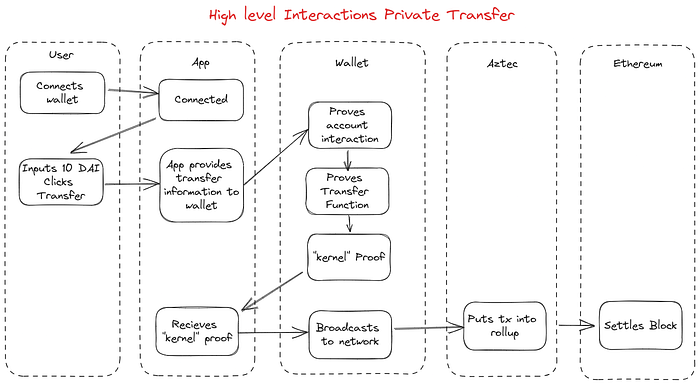
Here is the flow diagram for an Aztec transaction:
We’ll talk through each in turn.
Before we carve the patient open and look at its guts, know that there are two transaction paths within Aztec: private transactions and public transactions, each with their own attributes.
At the center of these transactions is something called the kernel circuit. The kernel circuit is the beating heart of the Aztec system, and validates private transactions. We’ll get back to it in a second.
For now let’s talk about what a blockchain transaction in general is:
We already discussed how Aztec allows for new forms of authorization, but how does it process transactions?
Aztec is a completely new execution environment beyond the EVM, and uses client-based zero knowledge proofs to prove individual transactions. That means the application developer’s job is to constrain functions appropriately and prove user intent.
Application developers can constrain user intents by writing smart contracts using Aztec.nr. In the private transfer example, the circuits behind the smart contract are checking a few conditions:
The nullifier, new note, an encrypted log are all made public, but kept encrypted, such that the public information tells you nothing about what happened. Roughly all an observer can see is “a transaction happened here but I’m not sure what.”
That’s the core of Aztec’s value proposition — we know with mathematical certainty transactions are happening that follow blockchain rules, but we can’t derive any information about those transactions.
📕 See our previous piece on how Aztec’s privacy abstraction works
The path for public transactions is slightly different, as Aztec relies on the familiar Ethereum account-based model for public transactions.
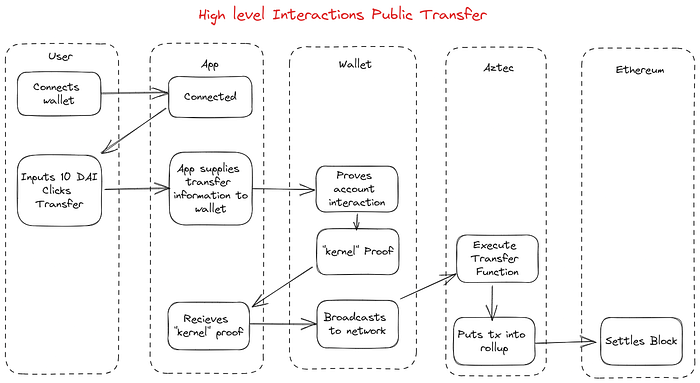
The key to Aztec’s public transactions are unconstrained functions–Aztec’s public VM bytecode. Unconstrained functions just do “normal code stuff.” And by “normal code stuff” we mean simply execution code rather than proving execution as in Aztec’s private execution path. Unconstrained functions don’t lay down constraints. They just executes code.
If Aztec is a world computer, then unconstrained functions are the instructions the computer understands. Just like the EVM executes Solidity, the Aztec VM executes Aztec bytecode.
One key difference between the private and public execution paths is when code gets executed. In the private transaction example, code must be executed and proven locally–that is, before proof of the transaction is sent to Aztec’s network of nodes.
In the public execution path, the wallet has to receive authorization, but doesn’t process the transaction, instead sending transaction details onward to an Aztec node which then creates a proof of execution and inserts the proof into a block.
Because privacy is no longer a concern with public transactions, they can be sent unencrypted to the node to do efficient batch processing, rather than relying on a user’s local device.
Privacy UX sucks. Zero knowledge is complicated. Our goal is two-fold:
Great privacy-first applications will be built on the backs of best-in-class tooling that makes it easy to build powerful software that makes preserving privacy smooth and intuitive for users.
That means more code, less cryptography.
To learn more about Aztec generally, keep up to date on our Discourse, where we discuss major protocol decisions like upgrade mechanisms and decentralizing sequencers.
For more technical news on Aztec and Noir, join our e-mail newsletter:
Aztec Labs is on the lookout for talented engineers, cryptographers, and business people to accelerate our vision of encrypted Ethereum.
👪 If joining our mission to bring scalable privacy to Ethereum excites you, check out our open roles.
And continue the conversation with us on Twitter.
Thank you to Bruno Lulinsky and Maddiaa for input on this piece.
Today we’re announcing Aztec.nr, a powerful new smart contract framework for Aztec applications. Aztec.nr enables smart contract developers to intuitively manage private state.
In other words, Aztec now has a smart contract language.
👀 Explore the Aztec.nr Github repo here
Aztec.nr is a framework built on top of Noir, an open-source, universal zk programming language to which Aztec Labs is a core contributor.
Aztec.nr allows developers to write private smart contracts in Noir and extend their functionality with templated functions that simplify state management.
Last week we teased how simple and intuitive private state management would be on Aztec.
📕 Read the first post in this series: Privacy Abstraction with Aztec
Today we’re explaining how Aztec.nr works and showing how you can get started building smart contracts and full-fledged privacy-preserving applications on Aztec.
The Aztec.nr framework helps you deal with complex note management that is critical to privacy preservation within smart contract development.
But it does so in a way that makes it so that developers don’t have to rebuild smart contract functionality from scratch every time they write a Noir program.
Without Aztec.nr, you wouldn’t be able to emit events, make calls to other contracts, or even have the notion of a contract or an address. You’d have no msg.sender or access to historic blockchain.
Aztec.nr takes Noir — a general zero knowledge programming language — and gives it the smart contract functionality and syntax developers might expect coming from Solidity.
Developers can now access a complete set of smart contract features:
For examples of Aztec.nr at work, check out examples of:
At Aztec Labs we harbor two very strong beliefs:
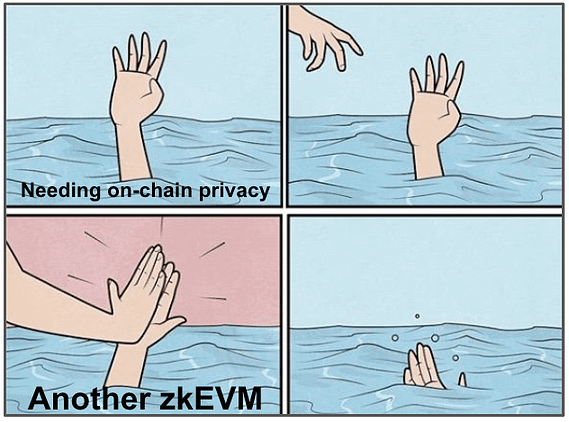
The Aztec.nr framework is a major step in improving the developer experience for managing private state — functionality that “vanilla” Noir doesn’t have.
For example for a simple private token contract, Aztec.nr includes helper functions like:
In other words, the kinds of functions you might expect to call in a standard token contract!
Let’s walk through this private token contract to show you how Aztec.nr helps with abstracting private note management:
Follow along in the Github repo of our private token contract example here
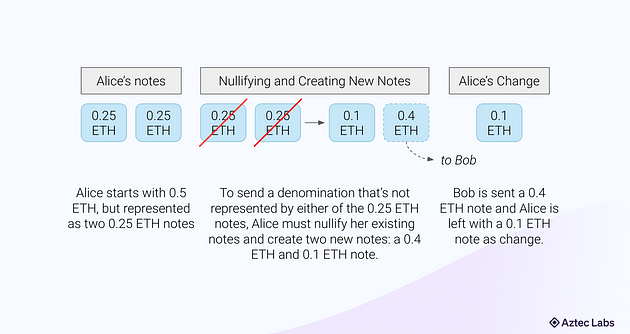
Say Alice wants to send funds to Bob. Practically, she would have to aggregate all of the existing non-nullified notes they have of the asset she were sending, add up the values, and once she had enough notes to send the amount, create a change note to reconcile her balance.
For example, say Alice had two UTXO’s of 0.25 ETH each, and wanted to send 0.4 ETH to Bob. In order to spend the note Alice would have to sum the two 0.25 ETH notes together, nullify them both, and create a change note for herself of 0.1 ETH.
Thankfully, Aztec.nr makes it easy to manage notes. Take for example the decrement and decrement_by_at_most functions written by the Aztec Labs team for the private token example above.
Here’s how decrement_by_at_most works:
Follow along with the decrement_by_at_most example here.
1. Find notes to decrement. The function begins by getting some notes that add up to max_amount or less from the set of notes owned by owner.

2. Destroy selected notes. It then iterates over these selected notes and destroys them, adding their values to a variable decremented.

3. Handle Change: If the total value of the destroyed notes (decremented) is greater than max_amount, it creates a new note with the excess value (change_value) and assigns it back to the owner.

4. Return the Decrement: Finally, the function returns the total value that was decremented, which is stored in decremented.
The decrement example is a perfect showcase for how Aztec.nr makes it easy to manage notes and nullifiers with built-in get, insert, replace, and remove functions.
If a dev wanted to write this without Aztec.nr (as in, write it with “vanilla” aka non-smart-contract Noir), they would have to write their own Merkle trees to insert and prove membership of notes and support non-membership checks for nullifiers.
But as a developer, you don’t have to worry about rebuilding core privacy primitives — the Aztec Labs team has already done all of that work on your behalf.
You just focus on smart contract logic.
Soon, anon, soon.
We’ll soon release a local developer environment for developers to write and test Aztec smart contracts against a local instance of an Aztec node.
Developers will soon get a full-fledged development kit for building smart contracts and applications on Aztec, supported by Aztec.nr’s functionality.
But for now, you can preview what comes in the box.
➡️ Explore the Aztec.nr Github repo here
Start familiarizing yourself with Noir syntax, since Aztec.nr is simply a smart contract framework written in vanilla Noir.
To get started learning Noir, check out:
Finally, sign up for Aztec Labs’ developer e-mail list to stay apprised of all technical developments across Noir and Aztec:
To learn more about Aztec generally, keep up to date on our Discourse, where we discuss major protocol decisions like upgrade mechanisms and decentralizing sequencers.
Aztec Labs is on the lookout for talented engineers, cryptographers, and business people to accelerate our vision of encrypted Ethereum.
If joining our mission to bring scalable privacy to Ethereum excites you, check out our open roles.
And continue the conversation with us on Twitter.
Private voting is the “real-world” default, and for good reason! Public voting has been problematic for DAOs, creating things like 11th hour problems, vote coercion, and bandwagon effects.
When NounsDAO recognized the need for confidential governance within their own community, Aztec Labs and Aragon ZK Research (AZKR) joined forces to answer the call.
We have now published two final reports on our research results and what’s next for NounsDAO private governance.
🤖 Read the technical report here.
👪 Read the general report here.
In short, our proposal was to provide privacy-first governance, including:
Now, at the conclusion of this research sprint, we are presenting our findings in the form of both technical and general reports.
The Aztec team focused on implementing storage proofs in Noir, while AZKR explored the design and implementation of the voting solution powered by these proofs.
In practice, prove that you’re a Noun without saying which Noun you are, then use that proof to vote in the DAO.
The general report also details the primary research questions addressed. TL;DR:
You can review the code and general report for AZKR’s early roadmap for what is currently called zk-POPVOTE (zk Proof-based On-chain Private Voting), which is a continuation of the project we’ve started together.
🐦 Join the Twitter Spaces we’ll host on September 5th at 12:00 UTC here
At Aztec Labs, we will continue contributing to the development of the Noir programming language, and we look forward to building privacy-preserving infrastructure to empower private governance.
Aztec is a first-of-its-kind public-private hybrid zkRollup bringing together the best of Ethereum smart contracts and encrypted execution.
It is a culmination of Aztec Labs’ long-term vision: a collectively-owned, fully decentralized L2 on Ethereum with encryption as a first class citizen.
We at Aztec Labs are thrilled to be able to build this together with you, and we can’t wait to see you in the forum.
Aztec Labs is on the lookout for talented engineers, cryptographers, and business people to accelerate our vision of encrypted Ethereum.
If joining our mission to bring scalable privacy to Ethereum excites you, check out our open roles.
Brand new to Noir? Start building your application with the universal language of zero-knowledge, supported by best-in-class developer advocates and developer relations engineers at Aztec. Get started here.
Noir was designed to be developer-first. This means simple and familiar Rust syntax, and now the support of the world’s most popular code editor. In just a matter of weeks, the extension has gone from ~70 to nearly 400 downloads.
Even if you’re new to the language — you won’t feel like you’re learning to program again, you’ll just start programming in zero-knowledge.
The following features should sound very familiar:
Differentiate key words from each other with color.
There are safety checks built into the language that will prevent certain mistakes (and subsequently, unexpected behaviors) before you make them. Noir x VS Code will let you know what they are instantly on file save, before you switch to terminal and compile.
Save time and key-strokes by utilizing quick code templates. Insert code snippets instead of writing function definitions repeatedly.
As of the latest version of the extension (version 0.0.4), you can run Noir tests, compile and execute Noir programs — all just one click away.
v0.0.4 is best paired with Nargo v0.10.3. Install Nargo with `noirup -v 0.10.3` and try it out.
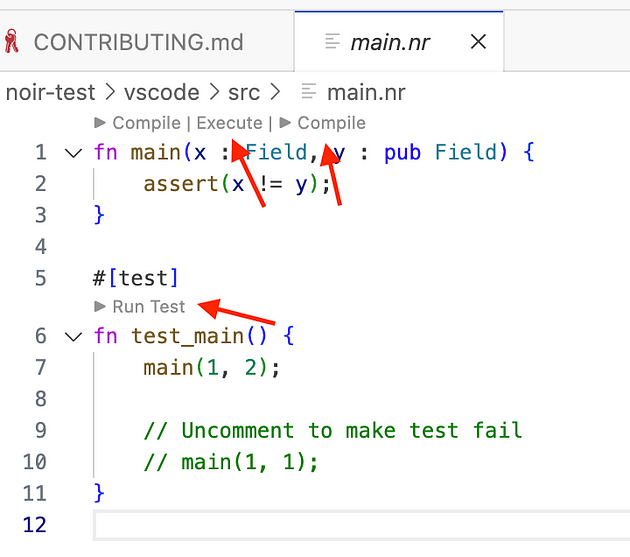
More features could be tackled like hover tooltip, auto formatting, and proving on click.
Want to contribute? Leave a message on the GitHub quest board.
Brand new to Noir? Start building your app with the universal language of zero-knowledge, supported by best-in-class developer advocates and developer relations engineers at Aztec.